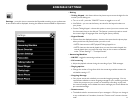
24
PART 68 OF FCC RULES INFORMATION
This equipment complies with Part 68 of the FCC rules and the requirements adopted
by the ACTA. On the bottom of this equipment is a label that contains, among other
information, a product identier in the format US:AAAEQ##TXXXX.
If requested, this number must be provided to the telephone company.
A plug and jack used to connect this equipment to the premises wiring and telephone
network must comply with the applicable FCC Part 68 rules and requirements ad-
opted by the ACTA. A compliant telephone cord and modular plug, RJ11C USOC, is
provided with the product. It is designed to be connected to a compatible modular
jack that is also compliant. See installation instructions for details.
The REN is used to determine the number of devices that may be connected to a
telephone line. Excessive RENs on a telephone line may result in the devices not ring-
ing in response to an incoming call. In most but not all areas, the sum of RENs should
not exceed ve (5.0). To be certain of the number of devices that may be connected
to a line, as determined by the total RENs, contact the local telephone company. For
products approved after July 23, 2001, the REN for the product is part of the product
identier that has the format US:AAAEQ##TXXXX. The digits represented by ##
are the REN without a decimal point (e.g., 03 is a REN of 0.3).
If this equipment causes harm to the telephone network, the telephone company will
notify you in advance that temporary discontinuance of service may be required. But if
advance notice isn’t practical, the telephone company will notify the customer as soon
as possible. Also, you will be advised of your right to le a complaint with the FCC if
you believe it is necessary.
The telephone company may make changes in its facilities, equipment, operations
or procedures that could affect the operation of the equipment. If this happens the
telephone company will provide advance notice in order for you to make necessary
modications to maintain uninterrupted service. If trouble is experienced with this
equipment, for repair or warranty information, please contact a Factory Service Cen-
ter or other Authorized Servicer. If the equipment is causing harm to the telephone
network, the telephone company may request that you disconnect the equipment
until the problem is resolved.
Connection to party line service is subject to state tariffs. Contact the state public
utility commission, public service commission or corporation commission for informa-
tion.
If your home has specially wired alarm equipment connected to the telephone line,
ensure the installation of this equipment does not disable your alarm equipment. If
you have questions about what will disable alarm equipment, consult your telephone
company or a qualied installer.
This equipment is hearing aid compatible as dened by the FCC in 47 CFR Section
68.316.
When you hold the phone to your ear, noise might be heard in your Hearing Aid.
Some Hearing Aids are not adequately shielded from external RF (radio frequency)
energy. If noise occurs, use an optional headset accessory or the speakerphone option
(if applicable) when using this phone. Consult with your audiologist or Hearing Aidma-
nufacturer about the availability of Hearing Aids, which provide adequate shielding to
RF energy commonly emitted by digital devices.
WHEN PROGRAMMING EMERGENCY NUMBERS AND (OR)
MAKING TEST CALLS TO EMERGENCY NUMBERS:
1) Remain on the line and briey explain to the dispatcher the reason for the call.
2) Perform such activities in the off-peak hours, such as early morning or late eve-
nings.
PART 15 OF FCC RULES INFORMATION
These devices (main telephone unit and wireless access point) comply with Part 15
of the FCC Rules. Operation is subject to the following two conditions: (1) These
devices may not cause harmful interference, and (2) these devices must accept any
interference received, including interference that may cause undesired operation.
CAUTION: Any changes or modications not expressly approved by the party
responsible for compliance could void the user’s authority to operate this device.
FCC REQUIREMENTS AND REGULATIONS


















